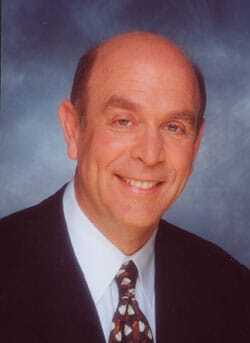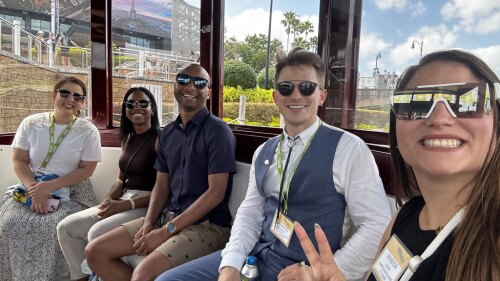| Richard Baron was awarded the J.C. Nichols Prize in 2004. |
Born and raised in a working-class area of Detroit, Richard Baron learned early about the social and economic dynamics of inner-city neighborhoods. Throughout his real estate career, Baron, 2004 laureate of the J.C. Nichols Prize for Visionaries in Urban Development, remained committed to developing mixed-income communities in central cities prone to decline and disinvestment. His firm, McCormack Baron Salazar (MBS), has made sustainable, affordable housing the cornerstone of its mission for rebuilding urban neighborhoods across the United States.
His focus on the living conditions in poor, largely minority communities took shape during his law school days at the University of Michigan and a fellowship with the Legal Aid Society in St. Louis, which included involvement in a rent strike against the St. Louis Housing Authority. In 1973, he joined with Terence McCormack to found a consulting and development firm that undertook several small housing projects serving low-income inner-city residents.
Following McCormack’s death in 1981, Baron decided to broaden the firm’s scope to include larger, more complex projects. Soon he was recruited to participate in a public/private partnership with the Kansas City Neighborhood Alliance, which proposed renovating and redeveloping a six-block historic neighborhood of elegant but mostly run-down homes known as Quality Hill. The neighborhood was transformed as a showcase through redevelopment of 15 renovated historic buildings and construction of 496 new townhouse and garden apartments, most for rent, and through streetscape improvements.
It became the hallmark of the MBS approach to profitable inner-city mixed-use and mixed-income development: cobbling together public, nonprofit, and private sources of financial support and working closely with area residents. In succeeding years, the firm developed many such projects, including Murphy Park in St. Louis, Centennial Place in Atlanta, and University Park in Memphis. MBS has become well-known throughout the United States for developing and managing mixed-income communities in central cities, including the renovation and improvement of important public facilities such as schools.
Harmony Oaks, an MBS development initiated in New Orleans in 2008 and now reaching completion, illustrates the current complexities of planning and funding mixed-income, inner-city redevelopment. MBS worked with what Baron called “a wonderful group of new residents,” plus MBS affiliate Urban Strategies Inc. and a local nonprofit group, to plan the new neighborhood. On the 41-acre (17-ha) former C.J. Peete public housing site (which had lost hundreds of its 1,403 housing units to long-term deterioration before Hurricane Katrina arrived), MBS built 460 mixed-income rental homes, restored two historic buildings, and constructed a new school, recreation center, gymnasium, and health clinic. A HOPE VI grant provided $20 million, and the Goldman Sachs Urban Investment Group provided a $58 million equity investment in the development. Corporate contributions came from the Ford Motor Company, the Kresge Foundation, and others.
Although Baron laments recent cutbacks in federal funding for low-income housing, he asserts that as at Harmony Oaks, the firm is finding other capital sources to support its work. He expects the company to do “what it’s always done,” he says, “although perhaps at a slower rate.” The firm has weathered other housing finance problems, Baron points out, such as the 1986 Tax Reform Act. Moreover, MBS continues to attract support for its mission from inner-city organizations, nonprofit partners, local public sources, and philanthropic organizations.
He also notes that though funding has been reduced for the HOPE VI program, which has provided substantial support for the firm’s developments, commitments that have already been made will stretch over several years of construction. Development of such projects may be slowed, but not halted.
Two examples are developments undergoing phased construction in Memphis. University Place is designed as a 473-unit mixed-income, multigenerational housing development in south-central Memphis on a site once occupied by public housing. HOPE VI funding of $22.5 million, added to $50 million from other sources, will support development in multiple phases of a seniors’ housing facility, multifamily apartments with one to three bedrooms, and a number of single-family homes. The project is a joint venture of MBS and Community Capital, a Memphis affordable housing provider; Urban Strategies, the management arm of MBS, will manage the finished project.
The same combination of partners is developing Legends Park just north of University Place, in the Memphis Medical Center area. It, too, received HOPE VI funding and will be developed as an affordable mixed-income community. HOPE VI grants for both projects were supported by Memphis HOPE and the city’s philanthropic community.
Baron says he is well aware of the need to adapt to evolving public funding mechanisms for promoting below-market-rate housing. He also is attuned to the growing public focus on the need for urban development to meet sustainability objectives, including transit-oriented development.
The advent of the U.S. Department of Housing and Urban Development’s Choice Neighborhoods program is presenting opportunities for projects that meet those goals. Baron was pleased when it was announced in September that San Francisco’s Alice Griffith Public Housing project was selected for one of the first six Choice Neighborhood grants from HUD.
The project is long overdue, as attested by the poor condition of the existing housing. The San Francisco Redevelopment Agency strongly supported the grant as an early step in planned mixed-use redevelopment of the entire 700-acre (280-ha) Candlestick Point/Hunters Point Shipyard. The HUD grant will allow MBS, selected as the prime developer, to launch the $30.5 million redevelopment process of replacing 256 run-down multifamily public housing units with high-quality housing. MBS development partner Urban Strategies already is involved in another shipyard renewal project to rebuild dilapidated housing in the Hunters Point community.
MBS’s engagement in green development has been recognized by the U.S. Green Building Council, which certifies Leadership in Energy and Environmental Design (LEED) awards. Baron proudly points out that MBS is the first development company in the world to have LEED certifications for two of its completed neighborhood developments: University Place and Renaissance Place, both in St. Louis, have achieved certification under the LEED–Neighborhood Development pilot program.
MBS also has been active in developing transit-friendly projects, an important element in meeting green development goals. The firm developed Metro Hollywood Apartments, the first transit village building in Los Angeles to serve low-income residents. It combines 60 apartments, 9,000 square feet (840 sq m) of retail space, and child care services above the Western/Hollywood subway station on the Red Line. A playground adjacent to the project links it to Carlton Court Apartments, the 61-unit first phase of the broader development. Residents have access through the station to Metro Red Line trains, and seven Metro bus lines service the area.
MBS also is planning the 90-unit MacArthur Park Apartments above the Westlake/MacArthur Park station on the Red Line. The project will incorporate green features such as highly energy-efficient heating and cooling systems, dual-glazed windows, water-saving fixtures, and recycled materials.
Baron is investigating opportunities in Detroit for initiating an ambitious reconstruction of a 3,000-acre (1,200-ha) green environment on the city’s east side. It centers on restoring one of the city’s historic streams, Bloody Run Creek, where Chief Pontiac’s braves defeated British forces in 1763. Over many decades, much of the stream has been buried and become part of the city’s sewer system. Now, restoration of the creek as an above-ground channel—called “daylighting” a stream as part of the natural landscape—is viewed as a stimulant for generating urban farms, alternative energy fields, recreation areas, and other activities that bolster the environment. The concept has already generated a $450,000 donation to map plans for the project from the Kresge Foundation, given to the Detroit Collaborative Design Center of the University of Detroit Mercy. Baron calls it “a transformational effort that could provide a real sense of excitement in the city.”




![20250517 PW - SAC Health - 02 web[1].jpg](https://cdn-ul.uli.org/dims4/default/43570aa/2147483647/strip/true/crop/2500x1405+0+130/resize/500x281!/quality/90/?url=https%3A%2F%2Fk2-prod-uli.s3.us-east-1.amazonaws.com%2Fbrightspot%2F07%2F06%2F6a84cb3148b78f5e1c660a2877a9%2F20250517-pw-sac-health-02-web1.jpg)
